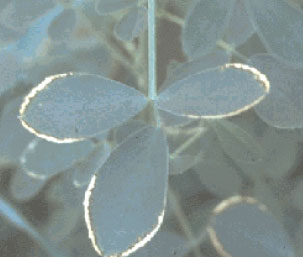Toxicity Symptoms
Field and Horticultural Crops
Alfalfa (Medicago sativa L.) and red clover (Trifolium pratense L.). Boron toxicity is marked by burnt edges on the older leaves (67,68) (Figure 8.4).Barley (Hordeum vulgare L.). Boron toxicity is characterized by elongated, dark-brown blotches at the tips of older leaves (79). Severe browning, spotting, and burning of older leaf tips occur, gradually extending to the middle portion of the leaf (59,63). There is a reduced shoot growth and increased leaf senescence (95).
Corn (Zea mays L.). Leaves show tip burn and marginal burning and yellowing between the veins (79,96). Burning of older leaf edges is more prominent (71).
Cowpea (Vigna sinensis Savi). Moderate boron toxicity results in marginal chlorosis and spotted necrosis, but under severe boron toxicity, trifoliate leaves show a slight marginal chlorosis (97).
Oat (Avena sativa L.). Boron toxicity in oats results in light-yellow bleached leaf tips (63).
 |
| FIGURE 8.4 Symptoms of boron toxicity in alfalfa (Medicago sativa L.) showing scorch at margins of lower leaves. |
Onion (Allium cepa L.). Boron toxicity results in burning of the tips of leaves, gradually increasing up to the base, and no development of bulb occurs (93).
Pea (Pisum sativum L.). Boron toxicity results in suppression of plant height and in the number of nodes (98). Unpublished data of Gupta and MacLeod (83) showed that boron toxicity results in burning of the edges of old leaves.
Potato (Solanum tuberosum L.). Boron toxicity symptoms include arching mid-rib and downward cupping of leaves and necrosis at leaf margins (85).
Rutabaga (Brassica napobrassica Mill.). The leaf margins are yellow in color and tend to curl and wrinkle. The symptoms on roots are similar to moderate boron deficiency symptoms—a watersoaked appearance of the tissues in the center of the root (99). Boron toxicity in turnip seedlings also results in marginal bleaching of the cotyledons and first leaves (100).
Bean (Phaseolus vulgaris L.). Boron toxicity results in marginal chlorosis of the older trifoliate leaves of snapbeans; unifoliate leaves are also chlorotic with intermittent marginal necrosis (97). Growth is suppressed, and old leaves have marginal burning (71). With faba beans (Vicia faba L.), stem growth was restricted, and the young leaves were wrinkled, thick, with a dark-blue color (101).
Strawberry (Fragaria x ananassa Duchesne). Slight boron toxicity was associated with marginal curling and interveinal bronzing and necrotic lesions. Under severe boron toxicity interveinal necrosis was severe, leaf margins became severely distorted and cracked, and overall plant growth was reduced (102).
Wheat (Triticum aestivum L.). Boron toxicity in wheat appears as light browning of older leaf tips converging into light greenish-blue spots (63). In durum wheat (Triticum durum Desf.), toxicity results in retarded growth, delayed heading, increase in aborted tillers, and suppressed grain yield per tiller (103).
Other Crops
Bajri (Pennisetum typhoideum). Boron toxicity results in the burning of leaf tips. On the basal leaves, small necrotic areas appear at the margins and proceed slowly toward the top of the plant (93).Bean (Phaseolus vulgaris L.). Excess boron causes mottled and necrotic areas on the leaves, especially along the leaf margins (91). In faba bean (Vicia faba L.), symptoms first appeared as yellowing of the mature foliage, followed by a marginal necrosis and finally by the death of the whole plant (101).
Tobacco (Nicotiana tabacum L.). Boron toxicity results in brown circular spots on the periphery of the leaves, and stunted growth (93).




